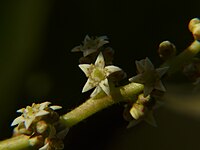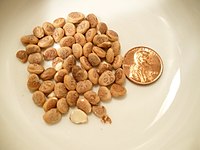| Buchanania cochinchinensis | |
|---|---|

| |
| Flowering charoli tree in Maharashtra, India | |
| Scientific classification | |
| Kingdom: | Plantae |
| Clade: | Tracheophytes |
| Clade: | Angiosperms |
| Clade: | Eudicots |
| Clade: | Rosids |
| Order: | Sapindales |
| Family: | Anacardiaceae |
| Genus: | Buchanania |
| Species: | B. cochinchinensis
|
| Binomial name | |
| Buchanania cochinchinensis | |
| Synonyms[1] | |
|
List
| |
Buchanania cochinchinensis, commonly known as charoli nut, almondette, Cuddapah almond, calumpong, Hamilton mombin,[2][3][4] is a deciduous tree of the cashew family. The charoli tree is native to the Indian subcontinent, South Central China, and much of Southeast Asia.[1]
The charoli tree produces fruit that is edible to humans.[3] The seeds are used as a cooking spice, especially in India.[4] Charoli seeds are also used in the Ayurveda, Unani, and Siddha systems of medicine.[2]
Description[edit]
The tree grows to about 20 metres (66 feet). Young branches are covered with dense, matted, woolly hairs. The leaves are 10–20 by 6–9 centimetres (3.9–7.9 by 2.4–3.5 inches), broadly oblong with emarginate (slightly indented at the tip) apices and rounded bases. The flowers are white and 0.3–0.4 centimetres (0.12–0.16 inches) in diameter. The drupes are 0.4–1 centimetre (0.16–0.39 inches) in diameter and subglobose (inflated, but not quite spherical) in shape. When ripe, they are stone hard and reddish-purple in color.[5] Flowering occurs March–April, and the fruit is generally harvested in the months of April to June.[6]
Taxonomy[edit]
Genus Buchanania is named for Francis Buchanan (1762–1829), a Scottish botanist, explorer, naturalist, and surgeon in the British East India Company.[2] B. cochinchinensis is one of 25 currently accepted species in genus Buchanania.[7] The species was first described as Toluifera cochinchinensis in 1790[8] by João de Loureiro, a Portuguese Jesuit missionary and botanist. Initially placed in genus Toluifera, the species was later included in multiple other genera, including Glycosmis, Lanzana, Loureira, Lundia, Mangifera, and Spondias. The species was most recently reclassified as Buchanania cochinchinensis in 1996.[9]
Distribution and habitat[edit]
The charoli tree is native to Bangladesh, Cambodia, China (south-central and Hainan), India, Laos, Myanmar, Nepal, Thailand, Vietnam, and the Western Himalayas. It grows primarily in the wet tropical and tropical rainforest biomes.[1][3]
Uses[edit]
Food and cooking[edit]
Though sometimes referred to as the "chironji nut" or "charoli nut",[2][4][10] the fruit is actually a type of drupe rather than a true botanical nut.[5] After the hard shell of the drupe is cracked, the stubby seed within is similar in texture to a pine nut.[10] The charoli seed is around 0.6 centimetres (0.24 inches) in length, with a flavor resembling an almond or a pistachio.[11] The seeds are used as a cooking spice, especially in Indian cuisine. Though they can be eaten raw, they are often toasted or roasted before use, as this intensifies the flavor of any nut or seed. They are commonly used in sweets in India, or ground into powders for thickening and flavoring savory sauces, batters and kormas.[10]
Traditional medicine[edit]
Charoli seeds are used in the Ayurveda, Unani, and Siddha systems of medicine. A decoction can be prepared from the bark of the stem or the leaves, to be used as a treatment for indigestion, mumps, impotence, spermatorrhea, heavy menstrual bleeding, diarrhea, or snakebite. This can also be used as an expectorant, aphrodisiac, or a laxative. The leaves can be crushed and applied to burns and wounds.[2]
Cultivation[edit]
The species is not commercially cultivated in India. The fruit is collected by local people from the forests and sold directly to the local markets. With a potential annual production of 5000 metric tonnes, Chhattisgarh is the highest-producing state in India for charoli fruit.[6] Leafhoppers, mealybugs, and bark-eating caterpillars (Indarbela spp.) are important pests of B. cochinchinensis, while gummosis and powdery mildew represent important pathogens.[6]
Significance in Buddhism[edit]

Circa 588 BCE,[12] the 35-year-old[13] Siddhartha Gautama stayed for seven weeks (7x7 days = 49 days = 1 sattasattāha) at Uruvela (modern Bodh Gaya), which is located in the present-day Indian state of Bihar. According to the Great Chronicle of Buddhas, he spent one week at each of seven successive locations there.[14] During these seven weeks, he did not eat or drink, wash or excrete, or lie down.[15][16][17] The specific locations were:
- Week 1: the Week on the Aparājita Throne (Pallanka Sattāha). After meditating under the Bodhi Tree for seven days and nights, he attained enlightenment, becoming the spiritual teacher known as the Buddha and the founder of Buddhism.[18]
- Week 2: the Week of the Gaze (Animisa Sattāha)[19]
- Week 3: the Week on the Walk (Cankama Sattāha)[20]
- Week 4: the Week at the Golden House (Ratanāghara Sattāha)[21]
- Week 5: the Week at the Ajapāla Banyan Tree[22]
- Week 6: the Week at Mucalinda Lake (Mucalinda Sattāha)[23]
- Week 7: the Week at the Rājāyatana Tree (Rājāyatana Sattāha)[15]
The seventh week was passed while sitting under a rājāyatana (B. cochinchinensis) tree, where the Buddha enjoyed the bliss of his newly attained buddhahood.[16][24][25] Upon the completion of this sattasattāha, several important "firsts" in Buddhism took place at the rājāyatana tree at Bodh Gaya, including:
- the first words of dharma to be uttered by the Buddha[16][26][27]
- the first lay disciples (two passing merchants from Pokkharavatī[28] named Tapussa and Bhallika) to take refuge in the teachings of the Buddha[16][26][27]
- the first food offering to the Buddha (rice cake and honey) after his enlightenment[16][26][27][29]
- the first Buddhist monk's bowl[26][27]
- the first relics of the Buddha to be distributed after his attainment of buddhahood[26][27][30]
According to Burmese folklore, Tapussa and Bhallika (the two passing merchants who became the Buddha's first lay disciples) later returned to their home in Okkalapa (Lower Burma), where they built a cetiya on Singuttara Hill (the Shwedagon Pagoda), where they enshrined the hair relics given to them by the Buddha.[27][30]
Gallery[edit]
-
Trunk
-
Buds
-
Buds
-
Flowers
-
Flowers
-
Charoli fruit
-
Charoli seeds
-
Leaves
-
Leaves
See also[edit]
References[edit]
- ^ a b c "Buchanania cochinchinensis (Lour.) M.R. Almeida". Plants of the World Online. Royal Botanic Gardens, Kew. Retrieved 27 January 2023.
- ^ a b c d e Quattrocchi 2012, pp. 676–678.
- ^ a b c India Biodiversity Portal 2023.
- ^ a b c Plants for a Future 2023.
- ^ a b Singh & Karthikeyan 2000, pp. 582–583.
- ^ a b c Malakar, Sahoo & Kumar 2022.
- ^ "Buchanania Spreng". Plants of the World Online. Royal Botanic Gardens, Kew. Retrieved 27 January 2023.
- ^ de Loureiro 1790, pp. 262–263.
- ^ Almedia 1996, p. 287.
- ^ a b c Bowen 2004.
- ^ Howes 1948, p. 210.
- ^ Barua 2003.
- ^ Dhammadharo 1998.
- ^ Sayadaw 2008, pp. 334–348.
- ^ a b Sayadaw 2008, pp. 346–347.
- ^ a b c d e Goldberg & Decary 2013, p. 125.
- ^ Bopearachchi 2016, pp. 24–26.
- ^ Sayadaw 2008, pp. 334–336.
- ^ Sayadaw 2008, pp. 336–337.
- ^ Sayadaw 2008, p. 337.
- ^ Sayadaw 2008, pp. 337–340.
- ^ Sayadaw 2008, pp. 340–345.
- ^ Sayadaw 2008, pp. 345–346.
- ^ Sayadaw 2008, p. 346.
- ^ Bopearachchi 2016, p. 24.
- ^ a b c d e Strong 2004, pp. 73–74.
- ^ a b c d e f Sayadaw 2008, p. 347.
- ^ Theragāthā Commentary 1.1-7: "Commentary on the stanza of Bhalliya Thera". Translation in Woodward, F.L., 1940, 1952, 1959, 'Theragāthā-aṭṭhakathā: the commentary of Dhammapālācariya', 3 volumes, Pali Text Society London
- ^ Bopearachchi 2016, p. 25.
- ^ a b Goldberg & Decary 2013, p. 126.
- ^ Beddome 1869, p. 165.
Bibliography[edit]
- Almedia, Marselin Rusario (1996). "Buchanania cochinchinensis (Lour.)". Flora of Maharashtra. 1.
- Barua, Sukomal (2003). "Buddha Purnima". In Islam, Sirajul; Jamal, Ahmed A. (eds.). Banglapedia: National Encyclopedia of Bangladesh. Vol. 3 (2nd ed.). Nimtali, Dhaka, Bangladesh: Asiatic Society of Bangladesh. ISBN 978-9843205766. Archived from the original on 8 May 2016. Retrieved 26 January 2023.
- Beddome, R.H. (1869). "XXXIII: Anacardiaceae". The Flora Sylvatica for southern India. Vol. 1. Madras: Gantz Brothers.
- Bopearachchi, Osmund (2016). Seven Weeks after the Buddha's Enlightenment: Contradictions in Text, Confusions in Art. New Delhi: Manohar Publishers & Distributors. ISBN 978-9350981375. Archived from the original on 28 January 2023. Retrieved 27 January 2023.
- Bowen, Dana (28 April 2004). "Temptation; Charoli Nuts Flavor the Dishes, and Memories, of Indian Chefs". The New York Times. Archived from the original on 10 October 2022. Retrieved 27 January 2023.
- de Loureiro, João (1790). "Genus IV: Toluifera". Flora Cochinchinensis (in Latin). 1. Archived from the original on 26 January 2023. Retrieved 26 January 2023.
- Dhammadharo, Ajahn Lee (1998). "Visakha Puja". Access to Insight. Translated by Bhikkhu, Thanissaro. Barre, Massachusetts: Barre Center for Buddhist Studies. Archived from the original on 4 March 2012. Retrieved 27 January 2023.
- Goldberg, Kory; Decary, Michele (2013). Along the Path: The Meditator's Companion to Pilgrimage in the Buddha's India and Nepal (2nd ed.). Onalaska, Washington: Pariyatti Press. ISBN 978-1938754586. Archived from the original on 27 January 2023. Retrieved 27 January 2023.
- Howes, Frank Norman (1948). "Miscellaneous and Little-known Nuts". Nuts: Their Production and Everyday Uses. London: Faber and Faber. Archived from the original on 27 January 2023. Retrieved 27 January 2023.
- India Biodiversity Portal (2023). "Buchanania cochinchinensis (Lour.) Almeida". India Biodiversity Portal. Archived from the original on 11 May 2021. Retrieved 27 January 2023.
- Malakar, Ayushman; Sahoo, Hareram; Kumar, Aditya (2022). "Commercial cultivation procedure of Chironji (Buchanania cochinchinensis (Lour.) M.R. Almedia): A money spinning native tree species of India". International Journal of Humanities, Engineering, Science and Management. 3 (1). doi:10.13140/RG.2.2.25073.76646/1. ISSN 2582-8169.
- Plants for a Future (2023). "Buchanania lanzan - Spreng". Plants For A Future (PFAF). Dawlish, England: Plants for a Future. Archived from the original on 14 December 2022. Retrieved 27 January 2023.
- Quattrocchi, Umberto (2012). "Buchanania Sprengel Anacardiaceae". CRC World Dictionary of Medicinal and Poisonous Plants: Common Names, Scientific Names, Eponyms, Synonyms, and Etymology. New York: Taylor & Francis Group. ISBN 978-1482250640. Archived from the original on 12 March 2023. Retrieved 27 January 2023.
- Sayadaw, Mingun, ed. (2008). "The Buddha's stay at the Seven Places". The Great Chronicle of Buddhas (PDF). Vol. 2 (Singapore ed.). Archived (PDF) from the original on 13 April 2022. Retrieved 27 January 2023.
- Singh, N.P.; Karthikeyan, S., eds. (2000). "Buchanania Spreng.". Flora of Maharashtra State (PDF). Flora of India. Vol. 1 (1st ed.). Kolkata: Botanical Survey of India. Archived (PDF) from the original on 26 January 2023. Retrieved 26 January 2023.
- Strong, John S. (2004). Relics of the Buddha. Princeton, New Jersey: Princeton University Press. ISBN 978-0691117645. Archived from the original on 27 January 2023. Retrieved 27 January 2023.
- Vicittasarabhivamsa, Bhaddanta, ed. (2006). "The Buddha's stay at the Seven Places". The Great Chronicle of Buddhas (PDF). Vol. 2, Part 1. Yangon, Myanmar: Ti=Ni Publishing Center. Archived (PDF) from the original on 12 March 2023. Retrieved 28 January 2023.
![Botanical illustration by Richard Henry Beddome, 1869[31]](https://upload.wikimedia.org/wikipedia/commons/thumb/9/91/Buchanania_latifolia_Govindoo.jpg/114px-Buchanania_latifolia_Govindoo.jpg)








